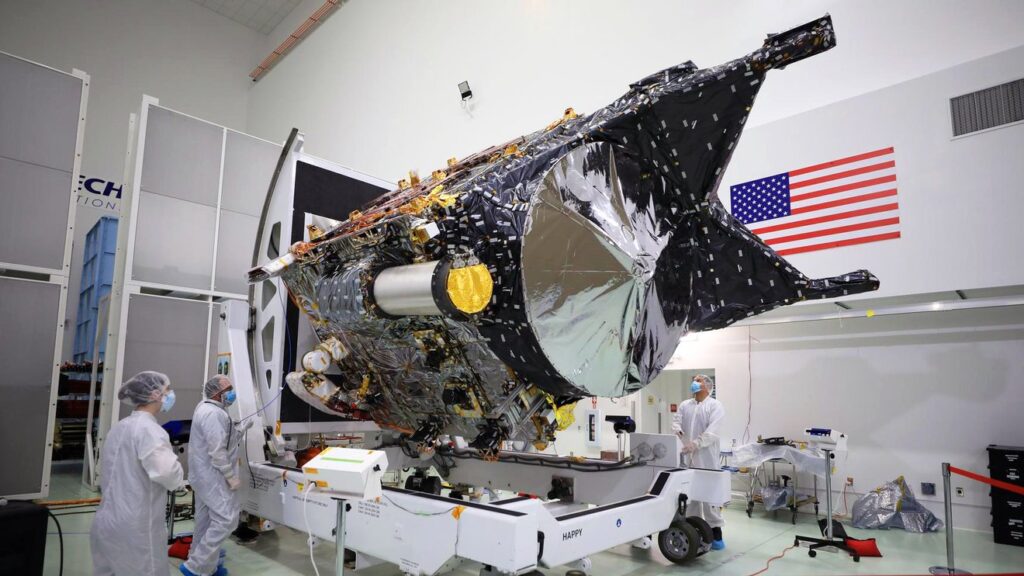NASA’s Milestone
An innovative first for NASA’s Deep Space Optical Communications (DSOC) project has been reached! The Hale Telescope at Caltech’s Palomar Observatory in San Diego County, California, has received a near-infrared laser that has been encoded with test data from nearly 10 million miles (16 million kilometers) away—over 40 times farther than the Moon is from Earth. With this incredible accomplishment, optical communications are demonstrated in the farthest-ever way.
Credit: NASA/JPL-Caltech
The Technology Behind NASA Deep Space Communication

NASA’s Deep Space Optical Communications (DSOC)
Here are five key points about this cutting-edge technology:
- Laser Communication Revolution: – By being the first to employ laser communications to send data from deep space, DSOC represents a major turning point for NASA.
- When it comes to communication beyond the Moon, DSOC uses lasers to achieve 10 to 100 times higher data transfer capacity than regular radio waves. – Imagine it as the evolution of fiber optics from the old telephone lines to the new ones on Earth, where advances in technology have been pushed by the need for data.
- In-Space and Ground Components: – DSOC uses technology that is both Earth-based and space-based.
- The Psyche spacecraft of NASA is equipped with a DSOC flight laser transceiver. For mission operations, Psyche mostly uses conventional radio communications.
- Features of the aircraft laser transceiver:
- A transmitter for near-infrared laser to relay high-rate data to Earth.
- A photon-counting camera that is sensitive enough to detect laser beams coming from Earth.
- Still, that’s not all! Two terrestrial telescopes have been upgraded to support DSOC:
- The operations team is housed at NASA’s Jet Propulsion Laboratory in Southern California.
- At JPL’s Table Mountain site near Wrightwood, California, a high-power near-infrared laser transmitter is connected with the Optical Communications Telescope Laboratory.
- Testing Beyond Mars: – The first laser communications demonstration from as far away as Mars will be made by DSOC.
- DSOC will launch concurrently with NASA’s Psyche mission in order to test critical technologies:
- Facilitating the transfer of denser science data.
- Maybe video streaming from Red Planet.
This advancement in communication capabilities will improve research instrument resolution and enable upcoming robotic and human exploration missions
- Increased Data Rates: – NASA has only used radio waves up until this point for deep space communication.
- Data rates far higher than those of current state-of-the-art systems are promised by DSOC’s laser technology.
- Imagine being able to send enormous volumes of data beyond the solar system, completely changing our knowledge of the universe.
- Pioneering the Future: – DSOC is a big stride in the direction of space communication’s future. This breakthrough in optical communication will enable us to connect, communicate, and solve riddles across enormous stretches of space as we explore far-off worlds.
In conclusion, DSOC is about more than simply data; it’s about using light-speed communication to bridge the cosmic divide.
Challenges Faced by Deep Space Communication
Although deep-space communication is amazing and crucial to our understanding of the universe, it also poses a number of extremely difficult problems. Let’s examine a few of these obstacles:
- Vast Distances: Signals must travel over enormous distances due to the vastness of space. Even with its accelerated speed, light still takes hours or even minutes to return to Earth from far-off planets, moons, or asteroids. Real-time communication is made more difficult by this delay, which calls for sophisticated protocols to manage latency.
- Signal Degradation: Various obstructions are encountered by signals as they travel across space. Signal distortion or attenuation can be caused by radiation, cosmic dust, and other astronomical events. Strong communication systems that can withstand these difficulties and still provide reliable data must be designed by engineers.
- Power Restraints: The power available to spacecraft is restricted. Energy is used in the transmission of high-power signals over long distances. The power efficiency and signal strength need to be balanced by engineers. Important parts are solar panels and effective transmitters.
- Bandwidth Constraints: Deep space communication has a limited amount of available bandwidth. We can’t just install more fiber-optic lines like we can with terrestrial networks. Data streams must be carefully allocated and prioritized in order to avoid saturation of available frequencies.
- Pointing Accuracy: To keep a steady connectivity, antennas on board spacecraft and ground stations need to line up exactly. Pointing difficulties are introduced by elements such as spacecraft spin, atmospheric turbulence, and Earth’s rotation. Phased-array antennas are one innovation that helps with this.
- Atmospheric Interference: Signals can be distorted by the atmosphere of Earth. High-altitude sites are frequently used by ground-based observatories to reduce atmospheric interference. Space-based observatories completely sidestep this problem.
- Security and Privacy: It’s imperative to guard against unauthorized access and interference when it comes to deep space communication. Secure protocols and encryption are necessary to protect sensitive data.
- Reliability : Scientific objectives, time, and money are heavily committed to space missions. To guarantee mission success, communication systems need to be extremely dependable. Backup systems, fail-safes, and redundancy all play important roles.
The communication between spacecraft and radio waves from natural sources, including pulsars, can be disrupted by Interference from Celestial Sources. Differentiating between manufactured and natural signals is a prerequisite for engineers.
- Adaptability: Unexpected situations arise during space missions. Systems for communication must adjust to shifting circumstances, such as planetary alignments, solar flares, or unforeseen occurrences.
In spite of these obstacles, humanity is still pushing the envelope in deep space communication. Novel approaches to our cosmic talks are promised by developments in artificial intelligence and optical communication, as exemplified by DSOC. 🚀🌌🔭